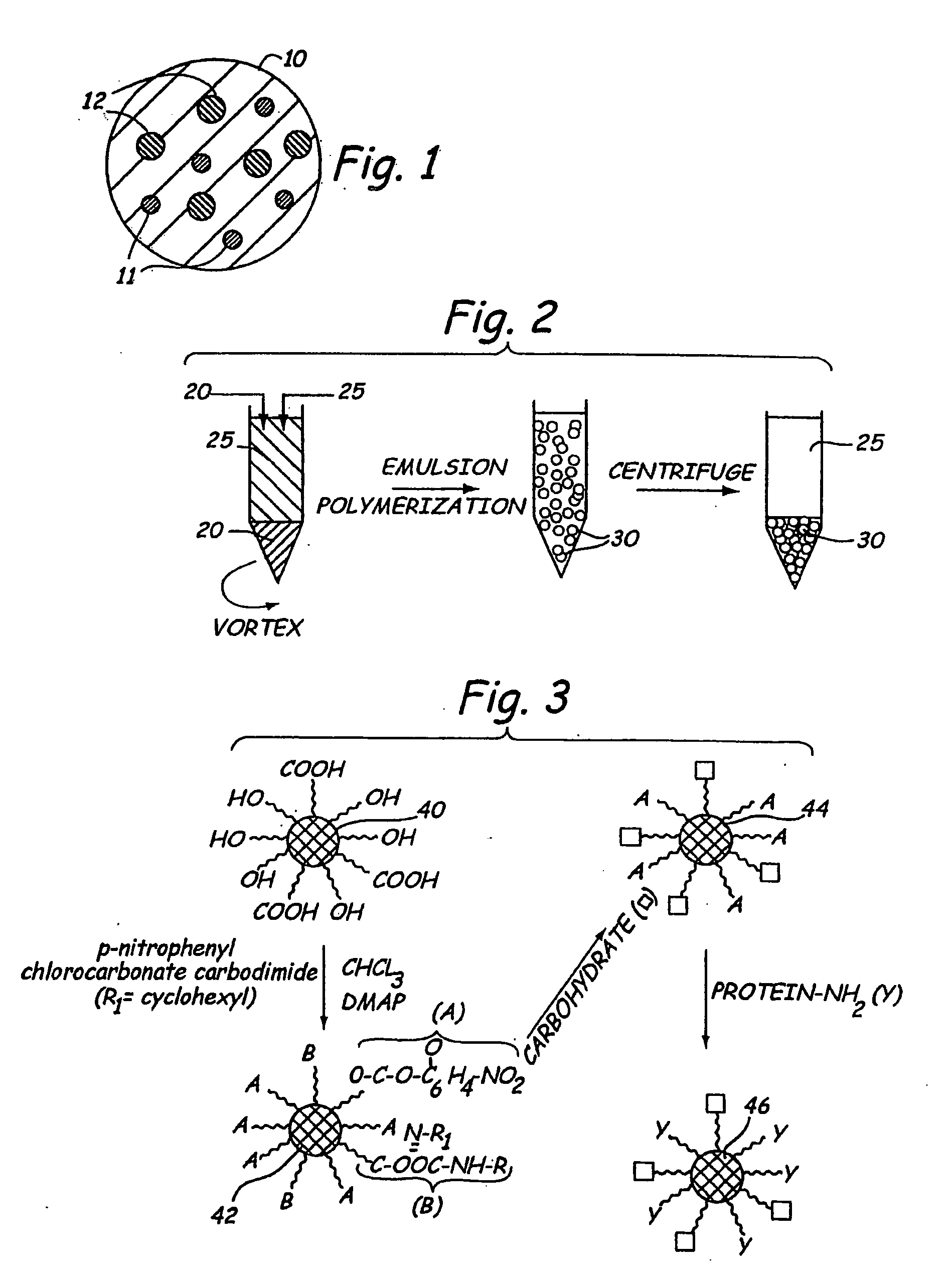Composite hydrogel drug delivery systems
a technology of drug delivery system and hydrogel, which is applied in the direction of drug delivery mechanism, powder delivery, pill delivery, etc., can solve the problems of high dose potential toxic side effects, inefficient fashion, and no suitable absorbable system is known that can deliver both water soluble and water insoluble relatively low molecular weight drugs, and achieve low molecular weight compounds.
- Summary
- Abstract
- Description
- Claims
- Application Information
AI Technical Summary
Benefits of technology
Problems solved by technology
Method used
Image
Examples
example 1
[0123]Formation of Hydrogel Microspheres
[0124]Almost monodisperse hydrogel microspheres, similar in size and density to circulating white blood cells such as neutrophils and leukocytes, may be formed that contain dangling functional groups or a bio-active agent. One way of forming such microspheres is by creating a water in oil suspension using an aqueous solution of a water soluble free radical polymerizable macromer.
[0125]Preparation of Microdroplets in Accordance with the Present Invention on a laboratory scale is possible using sonication induced by a probe sonicator. For industrial scale production, Microfluidization® (Microfluidics Corp., Newton, Mass.) is preferred. That process creates high shear by colliding opposing jets of liquid. The apparatus is described by Mayhew et al., “Characterization of Liposomes Prepared Using a Microemulsifier”, Biochim. Biophys. Acta, 775:169-174 (1984). Alternative industrially scalable processors include, but are not limited to, the Gaulin a...
example 2
Fabrication of Targetable Microspheres
[0132]In addition to di-functional macromers, if semitelechelic macromers having free hydroxyl or carboxyl groups also are added to the aqueous phase, the resulting microspheres may be expected to have free functional groups available for further functionalization. If the dangling chain ends are selected from a mix of hydroxyl and carboxyl groups, separate activation schemes may be used to couple both carbohydrates and protein signaling sequences to the microspheres.
[0133]Mucins are carbohydrate molecules present on the surface of leukocytes and other white blood cells. These long chain molecules have a flexible nature and act as tethers for cell signaling molecules. These molecules, for example, allow leukocytes to identify target sites through their rolling action. Poly(ethylene oxide) molecules possess chain flexibility by virtue of their ether linkages and may be functionalized at their ends. Thus, these molecules may be used as tethers that...
example 3
Preparation of a Hydrogel Tablet
[0141]Eosin Y is illustratively chosen as a model water soluble drug, because it is freely soluble in water. 300 mg of Eosin Y may be mixed with 1 g of ethyl stearate and the mixture gently heated to 45° C. for 1 minute to allow the Eosin to dissolve and freely mix with the molten ethyl stearate. The mixture should be allowed to cool and crystallize. The mixture is then scraped from the container and transferred to a ball mill to grind the powder to a small particle size.
[0142]The ground powder should be sieved through a 100 mesh screen and the particles collected. 300 mg of such particles may be dispersed into a macromer solution prepared as follows. An acrylated copolymer of dl-lactic acid and poly(ethylene glycol) (PEG molecular weight 8,000 daltons, 10 moles of lactoic ester per mole of PEG) may be synthesized as described in the foregoing paper by Sawhney et al., and dissolved in a phosphate buffered solution at a pH of 7.4 and a concentration of...
PUM
| Property | Measurement | Unit |
|---|---|---|
| melting point | aaaaa | aaaaa |
| size | aaaaa | aaaaa |
| solubility | aaaaa | aaaaa |
Abstract
Description
Claims
Application Information
 Login to View More
Login to View More - R&D
- Intellectual Property
- Life Sciences
- Materials
- Tech Scout
- Unparalleled Data Quality
- Higher Quality Content
- 60% Fewer Hallucinations
Browse by: Latest US Patents, China's latest patents, Technical Efficacy Thesaurus, Application Domain, Technology Topic, Popular Technical Reports.
© 2025 PatSnap. All rights reserved.Legal|Privacy policy|Modern Slavery Act Transparency Statement|Sitemap|About US| Contact US: help@patsnap.com


